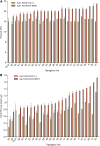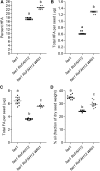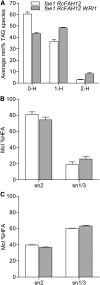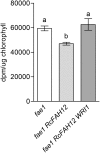WRINKLED1 Rescues Feedback Inhibition of Fatty Acid Synthesis in Hydroxylase-Expressing Seeds
- PMID: 27208047
- PMCID: PMC4854691
- DOI: 10.1104/pp.15.01906
WRINKLED1 Rescues Feedback Inhibition of Fatty Acid Synthesis in Hydroxylase-Expressing Seeds
Abstract
Previous attempts at engineering Arabidopsis (Arabidopsis thaliana) to produce seed oils containing hydroxy fatty acids (HFA) have resulted in low yields of HFA compared with the native castor (Ricinus communis) plant and caused undesirable effects, including reduced total oil content. Recent studies have led to an understanding of problems involved in the accumulation of HFA in oils of transgenic plants, which include metabolic bottlenecks and a decrease in the rate of fatty acid synthesis. Focusing on engineering the triacylglycerol assembly mechanisms led to modest increases in the HFA content of seed oil, but much room for improvement still remains. We hypothesized that engineering fatty acid synthesis in the plastids to increase flux would facilitate enhanced total incorporation of fatty acids, including HFA, into seed oil. The transcription factor WRINKLED1 (WRI1) positively regulates the expression of genes involved in fatty acid synthesis and controls seed oil levels. We overexpressed Arabidopsis WRI1 in seeds of a transgenic line expressing the castor fatty acid hydroxylase. The proportion of HFA in the oil, the total HFA per seed, and the total oil content of seeds increased to an average of 20.9%, 1.26 µg, and 32.2%, respectively, across five independent lines, compared with 17.6%, 0.83 µg, and 27.9%, respectively, for isogenic segregants. WRI1 and WRI1-regulated genes involved in fatty acid synthesis were up-regulated, providing for a corresponding increase in the rate of fatty acid synthesis.
© 2016 American Society of Plant Biologists. All Rights Reserved.
Figures








Similar articles
-
Overexpression of Seipin1 Increases Oil in Hydroxy Fatty Acid-Accumulating Seeds.Plant Cell Physiol. 2018 Jan 1;59(1):205-214. doi: 10.1093/pcp/pcx177. Plant Cell Physiol. 2018. PMID: 29149288
-
A small phospholipase A2-α from castor catalyzes the removal of hydroxy fatty acids from phosphatidylcholine in transgenic Arabidopsis seeds.Plant Physiol. 2015 Apr;167(4):1259-70. doi: 10.1104/pp.114.253641. Epub 2015 Feb 9. Plant Physiol. 2015. PMID: 25667315 Free PMC article.
-
A fatty acid condensing enzyme from Physaria fendleri increases hydroxy fatty acid accumulation in transgenic oilseeds of Camelina sativa.Planta. 2014 Sep;240(3):599-610. doi: 10.1007/s00425-014-2122-2. Epub 2014 Jul 15. Planta. 2014. PMID: 25023632
-
A multigene approach secures hydroxy fatty acid production in Arabidopsis.J Exp Bot. 2022 May 13;73(9):2875-2888. doi: 10.1093/jxb/erab533. J Exp Bot. 2022. PMID: 35560203 Review.
-
Current progress towards the metabolic engineering of plant seed oil for hydroxy fatty acids production.Plant Cell Rep. 2015 Apr;34(4):603-15. doi: 10.1007/s00299-015-1736-6. Epub 2015 Jan 11. Plant Cell Rep. 2015. PMID: 25577331 Review.
Cited by
-
Castor patatin-like phospholipase A IIIβ facilitates removal of hydroxy fatty acids from phosphatidylcholine in transgenic Arabidopsis seeds.Plant Mol Biol. 2019 Dec;101(6):521-536. doi: 10.1007/s11103-019-00915-w. Epub 2019 Sep 23. Plant Mol Biol. 2019. PMID: 31549344
-
Molecular Basis of Plant Oil Biosynthesis: Insights Gained From Studying the WRINKLED1 Transcription Factor.Front Plant Sci. 2020 Feb 4;11:24. doi: 10.3389/fpls.2020.00024. eCollection 2020. Front Plant Sci. 2020. PMID: 32117370 Free PMC article. Review.
-
Development Defects of Hydroxy-Fatty Acid-Accumulating Seeds Are Reduced by Castor Acyltransferases.Plant Physiol. 2018 Jun;177(2):553-564. doi: 10.1104/pp.17.01805. Epub 2018 Apr 20. Plant Physiol. 2018. PMID: 29678860 Free PMC article.
-
Identification of microRNAs involved in lipid biosynthesis and seed size in developing sea buckthorn seeds using high-throughput sequencing.Sci Rep. 2018 Mar 5;8(1):4022. doi: 10.1038/s41598-018-22464-w. Sci Rep. 2018. PMID: 29507325 Free PMC article.
-
Enhanced production of hydroxy fatty acids in Arabidopsis seed through modification of multiple gene expression.Biotechnol Biofuels Bioprod. 2022 Jun 18;15(1):66. doi: 10.1186/s13068-022-02167-1. Biotechnol Biofuels Bioprod. 2022. PMID: 35717237 Free PMC article.
References
-
- Angeles-Núñez JG, Tiessen A (2012) Regulation of AtSUS2 and AtSUS3 by glucose and the transcription factor LEC2 in different tissues and at different stages of Arabidopsis seed development. Plant Mol Biol 78: 377–392 - PubMed
-
- Badami RC, Patil KB (1980) Structure and occurrence of unusual fatty acids in minor seed oils. Prog Lipid Res 19: 119–153 - PubMed
MeSH terms
Substances
LinkOut - more resources
Full Text Sources
Other Literature Sources
Molecular Biology Databases

